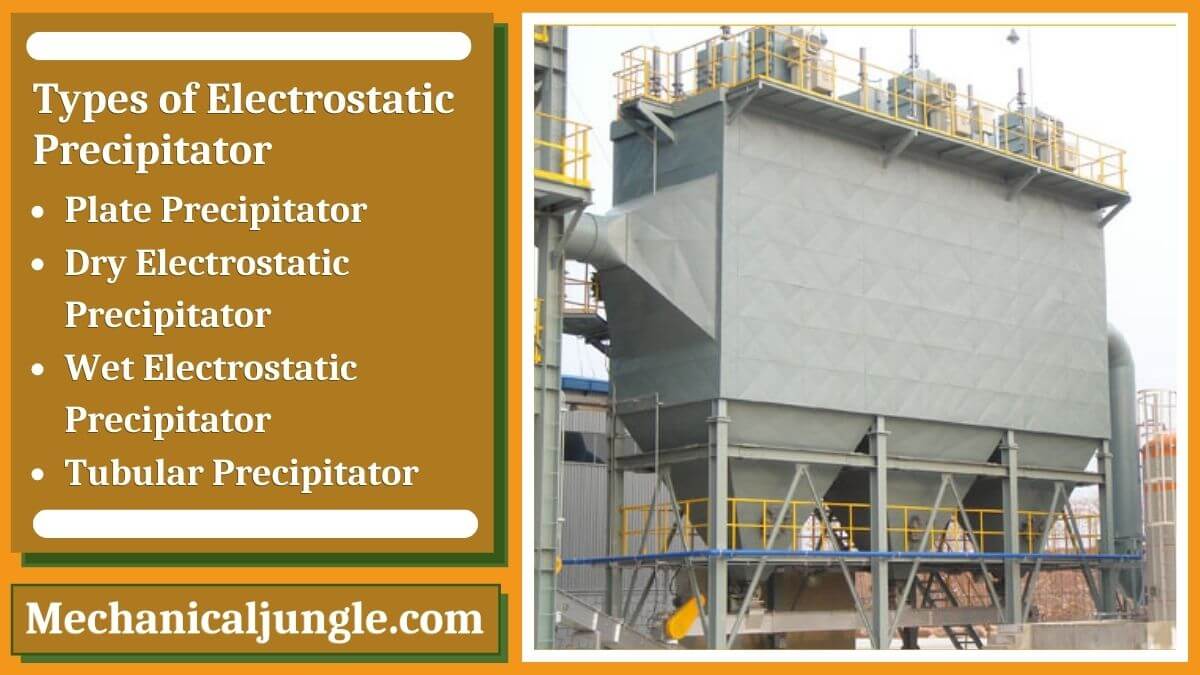Electrostatic Precipitator Working Principle:
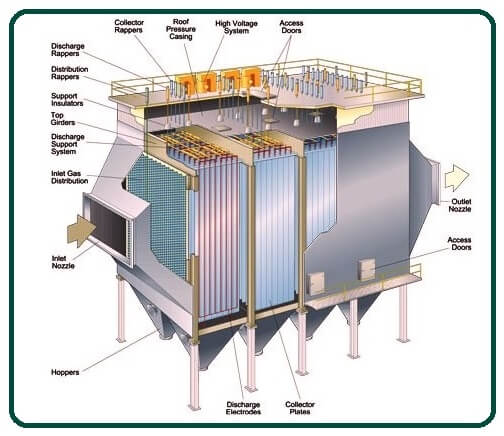
- The working principle of electrostatic precipitators is quite simples.
- It has two sets of electrodes; one is positives, and the other is negative.
Negatives electrodes are in the form of a rod or wire mesh. - Positive electrodes are in the form of plates.
- Positive plates and negatives electrodes are placed vertically alternately one after another in the electrostatic precipitator.

- Negative electrodes are connected to a negatives terminal of the high voltage dc source, and positive plates are connected to the positives terminal of the dc source.
- The positive terminal of the dc source can be grounded to achieve strong negativity in negative energy.
- The distance between each negative electrode and the positive plate and the dc voltage applied to them is so adjusted that the voltage gradient between each negative electrode and the adjacent positive plate becomes high enough to ionize the medium between these two.
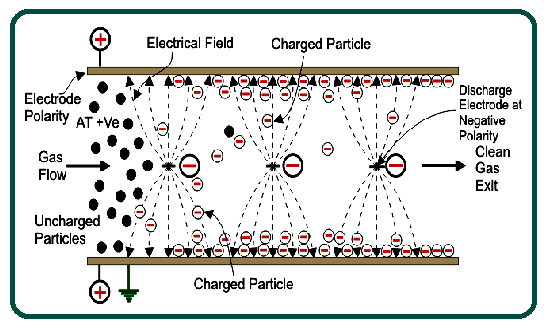
- The medium between electrodes is air, and due to the high negatives of the negative electrode, a corona discharge may occur around the negative electrode rods or wire mesh.
- Air molecules in the area between the electrodes are ionized, and so there will be a lot of free electrons and ions in the space.
- The entire system is enclosed by a metal container on which one side is provided with an inlet of flue gases, and the opposite side is provided with an outlet of filtered gases.
- As the flue gases enter the electrostatic precipitator, the dust particles in the gases collide with the free electrons available in the mediums between the electrodes, and the free electrons will join the dust particles.
- As a result, dust particles become negatively charged.
- These negatively charged particles would then be attracted due to the electrostatic force of the positive plates.
- As a result, charged dust particles move towards the positive plates and accumulate on the positive plates.
- Here, the extra electrons from the dust particles will be removed from the positive plates, and the particles will then fall due to the force of gravity.
- We call positive plates collecting plates.
After traveling through the electrostatic precipitator, the gru gases are almost free of ash particles and eventually reach the atmosphere through the chimney. - An electrostatic precipitator does not directly contribute to the production of electricity in thermal power plants, but it helps to keep the atmosphere cleans, which is quite important for living beings.
Hoppers are fitted under the electrostatic precipitator chamber to collect dust particles. - Water prayers at the top can be used to accelerate the removal of dust from the collecting plates.
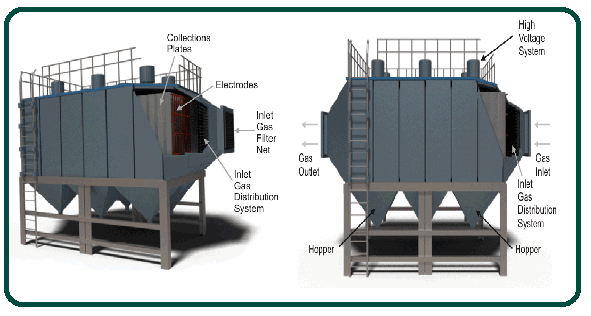
What Is Electrostatic Precipitator?

An electrostatic precipitator is defined as a filtration device that is used to remove microscopic particles such as smoke and fine dust from a flowing gas. It is a commonly used device for air pollution control. They are used in industries such as steel plants and thermal energy plants.
In the year 1907, professor of chemistry frederick dardner cottrell patented the first electrostatic precipitator, which was used to collect sulfuric acid mist and lead oxide fumes that were emitted from various acid-forming and smelting activities.
The Efficiency of Electrostatic Precipitator:
![]()
- 𝜼 =is the fractional collection efficiency where,
- w= is the terminal drift velocity in ms-1
- a =is the total collection area in m2
- q= is the volumetric airflow rate in m3s-1
Construction and Working of an Electrostatic Precipitator:
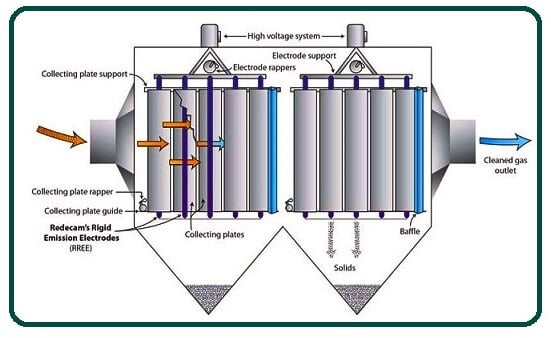
Electrostatic precipitators basically consist of a stack of flat vertical metal plates and a row of thin vertical wires. Plates have less than 0.5 inches to about 7 inches (the difference between them. Distance between the plates depending on the particulars application.
The stream of gases flows horizontally between the stack of plates and between the rows of vertical wires. A negative charge of thousand of volts is applied between the plate and the wires.
This helps to remove dust particles from the gas stream. This entire arrangement is housed inside a metal container.
On one side of the container, an inlet is present for impure gases, and on the opposite side, an outlet is provided for filtered gases. As impure gases enter the metal container, dust particles collide with the free electrons present between the electrodes.
The free electrons will then attach to the dust particles. As a result, dust particles will become negatively charged. These negatively charged particles will be attracted by the positive plates.
This will cause the charged dust particles to move towards the positive plates. Here, the dust particles will become neutral, and they will fall down due to the force of gravity. These positive plates are called collecting plates.
Types of Electrostatic Precipitator:
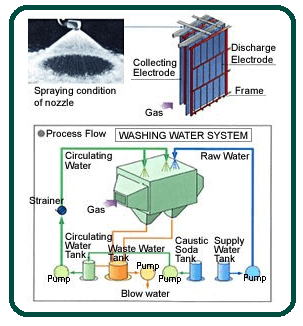
There are various electrostatic types, and here, we will study each one of them in detail.
The following are four types of esp:
- Plate Precipitator.
- Dry Electrostatic Precipitator.
- Wet Electrostatic Precipitator.
- Tubular Precipitator.
#1. Plate Precipitator:
- This is the most basic precipitator type consisting of rows of thin vertical wires and stacks of stacked flat metal plates that are spaced 1cm to 18cm apart.
- The air stream is passed horizontally through vertical plates and then through a large stack of plates.
- To ionize the particles, a negatives voltage is applied between the wire and the plate.
- These ionized particles are then twisted towards grounded plates using electrostatic force.
- As the particles collect on the collection plate, they are removed from the stream of air.
#2. Dry Electrostatic Precipitator:
- This precipitator is used to collect pollutants such as ash or cement in a dry state.
- It consists of electrodes through which ionized particles flow and a hopper through which the collected particles are ejected.
- Dust particles are collected by hammering electrodes from a stream of air.
#3. Wet Electrostatic Precipitator:
- This precipitator is used to remove resin, oil, tar, paint, which are wet in nature.
- It contains collectors that continuously spray with water and collect ionized particles from the sludge.
- They are more efficient than dry esp.
#4. Tubular Precipitator:
- This precipitator is a single-phase unit consisting of tubes with high voltage electrodes arranged parallel to each other as if they are running on their own axis.
- The arrangement of the tubes may be either spherical or square or may flow either upward or downward with hexagonal honeycomb gas.
- The gas is designed to pass-through all tubes.
- They find applications where viscous particles are to be removed.
Advantages of Electrostatic Precipitator:
The advantages of an electrostatic precipitator are as follows.
- Electrostatic precipitators have excellent efficiency and can be used to remove 99% of dust particles from impure air.
- They are capable of collecting both dry and wet pollutants.
- Dry precipitators collect dry pollutants, while wet precipitants collect humid pollutants.
- Electrostatic precipitators have low operating costs and are quite economically feasible in the long run.
Disadvantages of Electrostatic Precipitator:
The disadvantages of an electrostatic precipitator are as follows.
- Electrostatics precipitators have a very high capital cost making them unsuitable for small-scale industries.
- A very large space is required for the device to operate properly.
- Electrostatic precipitators cannot be used to remove gaseous pollutants.
- They are suitable only for dry and wet pollutants.
Applications of Electrostatic Precipitator:
An electrostatic precipitator is used for various applications in industries. Here, we have mentioned some of the most important applications of electrostatic precipitators:
- It is installed in steam plants to remove dust from impure gases.
- It can be used in chemical plants to remove oil mists and acid mists.
- It removes bacteria and fungi in various medical applications.
- It is used in air conditioning systems to purify the air.
Frequently asked questions (FAQs) related to electrostatic precipitators:
What is an electrostatic precipitator (ESP)?
An electrostatic precipitator is a device used to remove fine particles like dust and smoke from a flowing gas using the force of an induced electrostatic charge.
How does an electrostatic precipitator work?
It works by passing a gas stream between rows of charged plates and wires. Dust particles in the gas collide with free electrons, become negatively charged, and are then attracted to positively charged plates where they accumulate and are removed.
What are the main components of an electrostatic precipitator?
It typically consists of electrodes (positively charged plates and negatively charged wires), a high voltage power supply, collection plates, and a housing for gas flow.
What types of electrostatic precipitators are there?
There are several types: Plate Precipitator, Dry Electrostatic Precipitator, Wet Electrostatic Precipitator, and Tubular Precipitator, each suited for different applications and types of pollutants.
What are the advantages of electrostatic precipitators?
The have high efficiency in removing particles (up to 99%), are capable of handling both dry and wet pollutants, and have low operating costs over their lifespan.
What are the disadvantages of electrostatic precipitators?
They have high initial costs, require significant space for installation, and cannot effectively remove gaseous pollutants.
Where are electrostatic precipitators commonly used?
They are used in industries such as power plants (to clean flue gases), chemical plants (to remove acid and oil mists), and medical applications (for air purification).
How efficient are electrostatic precipitators in reducing air pollution?
Electrostatic precipitators can achieve high efficiency in removing particulate matter, contributing significantly to cleaner air and reducing environmental impact.
What maintenance is required for electrostatic precipitators?
Regular cleaning of collection plates and electrodes is necessary to maintain optimal performance. Inspections for electrical integrity and airflow are also important.
Are electrostatic precipitators environmentally friendly?
Yes, they help reduce air pollution by removing harmful particles from industrial emissions, contributing to better air quality and environmental health.

